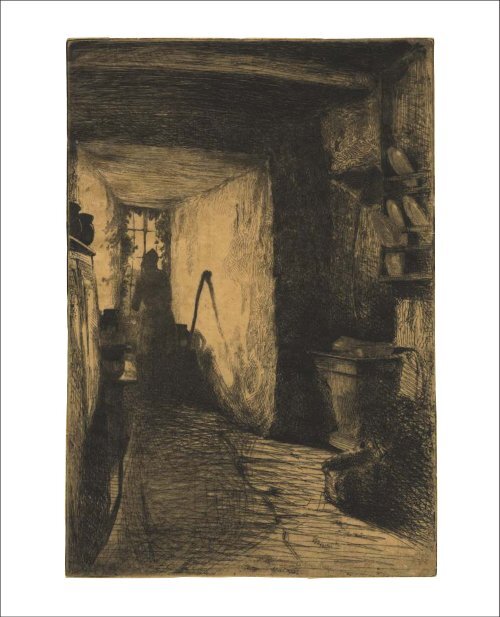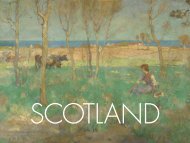Create successful ePaper yourself
Turn your PDF publications into a flip-book with our unique Google optimized e-Paper software.
[3] The Kitchen, 1858<br />
Etching on thin, yellowish-brown chine; trimmed to the platemark<br />
an impression in the second state (of three)<br />
Signed Whistler and inscribed Imp. Delatre. Rue St. Jacques. 171. in the<br />
plate at lower right<br />
815/16 x 6 3/16 inches (22.7 x 15.8 cm)<br />
Provenance: Alexander John Godby, Baltimore and London (Lugt<br />
1119b); Harlow, McDonald & Co., New York; Lucien Goldschmidt,<br />
Inc., New York<br />
Reference: Kennedy 24; Glasgow 16<br />
Whistler made several early drawings of kitchens in<br />
addition to a preliminary pencil sketch and the watercolour<br />
of this kitchen in Lutzelbourg in Alsace-Lorraine<br />
(now in the Freer Gallery of Art, Washington D.C.) that<br />
was used as the basis for this etching. He transferred the<br />
image of a peasant woman gazing through a window in<br />
her modest home to the copper etching plate after his<br />
return to Paris; it was published in the French Set in this<br />
second state. As Ruth Fine notes, this print “was considered<br />
during Whistler’s lifetime one of the most beautiful<br />
of the French Set” (p.39). Indeed, it was so popular that<br />
the artist reworked the copper plate and printed a new<br />
edition of 50 impressions, published by The Fine Art<br />
Society in 1884.<br />
Lochnan notes the influence of the quiet domestic<br />
scenes of the French Realist painter François Bonvin<br />
on Whistler’s subject here. But like Whistler’s other<br />
etchings of women in shadowy interiors and doorways,<br />
contemplative or absorbed in their tasks, this composition<br />
also reflects the underlying geometries and the sense<br />
of stillness found in the work of the seventeenth-century<br />
Dutch master Pieter de Hooch. Here Whistler further<br />
deploys de Hooch’s method of rhythmically juxtaposing<br />
light and dark areas to draw the eye around the picture<br />
plane and into the sequence of apparently receding spaces<br />
toward the window where the woman is shown silhouetted<br />
against the light (see Lochnan, pp.41–43).<br />
[4] The Dog on the Kennel, 1858<br />
Etching, printed in black ink on Japan paper, an impression in the<br />
second (final) state: there was no published edition<br />
2 3/4 x 3 1/2 inches (7.2 x 8.9 cm) sheet 5 1/4 x 6 1/4 inches (13.3 x 16 cm)<br />
Reference: Kennedy 18; Glasgow 19<br />
This was drawn during Whistler’s tour of the Rhineland<br />
in search of subjects for etchings to be published in the<br />
French Set, between 14th August and 7th October 1858.<br />
Both the kennel and the dog were also depicted in The<br />
Unsafe Tenement. Frederick Wedmore recorded that<br />
Whistler was working on the larger plate when the dog<br />
jumped up on the kennel, but put it aside to make the<br />
small study. This information came from Samuel P. Avery,<br />
whose Whistler collection is in the New York Public<br />
Library, and who first met the artist in 1867. The etching<br />
has been rarely exhibited but was lent by Avery to the<br />
Union League Club in New York in 1881.<br />
james mcneill whistler: prints 13



